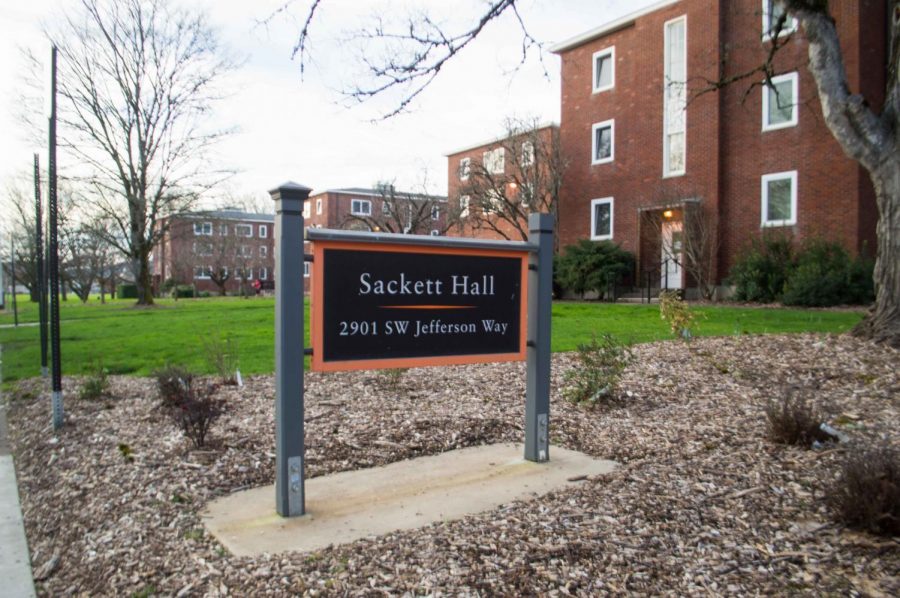Oregon State University moves to increase accessibility on campus
February 29, 2016
Oregon State University officials want to continue to make the campus more accessible.
“You can stand almost anywhere on campus and I can point out where we’ve made an improvement in the last five years,” said Gabriel Merrell, the associate director and deputy American Disabilities Act coordinator in the Office of Equal Opportunity and Access said.
This has led to the development of new offices devoted to encouraging diversity and many conversations and events that allow students and faculty to have conversations about social justice. Among the campaigns for inclusivity on campus is the ongoing effort to make the university and its resources more accessible for students with disabilities.
Basic disability access protocols are laid out in federal law. However, according to Merrell, OSU is working to go above and beyond these base requirements.
“We have aspirations to be an inclusive, just university,” Merrell said. “Truthfully, we’re trying to achieve that.”
These aspirations, according to Clay Simmons, chief compliance officer and interim director at the Office of Equal Opportunity and Access, are not just aspirations—they are also plans carried through and supported by university resources.
“We back that up with money,” Simmons said.
From 2015-17, OSU is on track to spend roughly $4.2 million on accessibility projects on campus. According to Simmons, disability access projects receive funding from the university and from the state.
Merrell and his colleagues work on projects that make buildings more accessible for students with disabilities. This includes working with other organizations on campus and getting involved with ongoing construction in order to implement accessible features. Merrell said the projects that he and his team work on have received moresupport than he would have expected.
“This is a topic that every campus in the country struggles with,” Merrell said. “And I know personally every campus in Oregon because I have colleagues throughout the state, and they’re all jealous of the amount of work we’ve been doing.”
According to Merrell, the new Strand Agriculture Building—STAG—serves as an example of some disability access work. Merrell and his colleagues work to get involved in construction projects like the renovations in STAG so that the addition of accessible features is as efficient as possible. Among the improvements in the STAG building are a ramp in front of the building and more bathrooms.
Additionally, Disability Access Services works to provide accommodations and resources for students with disabilities.
According to Martha Smith, the DAS director, DAS typically takes a more retroactive approach to providing students accommodations when and where they are needed.
Right now, DAS is working with the university to expand closed captioning of video resources made and used by the university and install audio plugins on the OSU website.
However, according to Merrell, there is still plenty of work to be done and some projects must take higher priority than others.
Hoveland Hall, for example, is a much older and more difficult to access. In order for a building to be in compliance with federal disability access law, the building must meet the standards that existed at the time of its construction. Because Hoveland is older, there were no laws in place at the time of its construction. Therefore, it is technically in compliance with current legal standards. Since it is generally smaller, a lower-traffic area and could quickly become very expensive, improving access in Hoveland is a much lower priority than other ongoing projects.
In the future, DAS and the Office of Equal Opportunity and Access hope to make more resources available to students with disabilities.
baro.news@oregonstate.edu


















































































![Newspaper clipping from February 25, 1970 in the Daily Barometer showing an article written by Bob Allen, past Barometer Editor. This article was written to spotlight both the student body’s lack of participation with student government at the time in conjunction with their class representatives response. [It’s important to note ASOSU was not structured identically to today’s standards, likely having a president on behalf of each class work together as one entity as opposed to one president representing all classes.]](https://dailybaro.orangemedianetwork.com/wp-content/uploads/2025/03/Screenshot-2025-03-12-1.00.42-PM-e1741811160853.png)
























